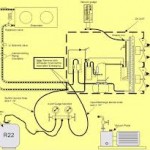Canadian English – Archived from the original on
Canadian English – Archived from the original on
Victor David Gruen, originally named Viktor David Grünbaum, was an Austrian-born American architect and urban planner. He was born on July 18, 1903, in Vienna, Austria, and later became a naturalized American citizen. Gruen is best known for his pioneering work in the field of shopping mall design and urban planning. Here are some key highlights of his life and career:

Canadian English – Archived from the original on
- Early Life and Education: Gruen studied architecture in Vienna, where he was influenced by modernist and Bauhaus design principles. He graduated from the Vienna Academy of Fine Arts.
- Emigration to the United States: Due to the rise of Nazism in Europe, Gruen emigrated to the United States in 1938, eventually settling in New York City. He changed his name from Viktor David Grünbaum to Victor David Gruen to better adapt to his new home.
- Architectural Career: Gruen established himself as an architect in the United States, working on various projects, including residential buildings and retail spaces. He became known for his innovative designs that focused on creating pleasant and functional environments for people.
- Pioneering Shopping Mall Design: Gruen is often credited with pioneering the design of the modern shopping mall. His most famous work in this regard is the design of Southdale Center, which opened in Edina, Minnesota, in 1956. Southdale Center is considered one of the first enclosed shopping malls in the United States and set the template for future mall designs.
- Urban Planning: Beyond shopping malls, Gruen was also interested in urban planning. He advocated for pedestrian-friendly urban environments and city centers. He believed that well-designed urban spaces could enhance the quality of life for residents and visitors.
- Impact: Victor Gruen’s ideas and designs had a profound impact on American retail and urban planning. His vision of creating attractive, walkable spaces for shopping and leisure influenced the development of shopping centers and downtown revitalization efforts.
- Later Life: In his later years, Gruen expressed regret that his shopping mall designs had become synonymous with suburban sprawl and car-dependent lifestyles. He believed that his original vision for shopping centers as community hubs had been largely lost.
Victor David Gruen passed away on February 14, 1980, in Vienna, Austria. While his work in shopping mall design has been both celebrated and critiqued, his legacy continues to influence the fields of architecture, urban planning, and retail design to this day.
- ^“History of Braille (UEB)”. Braille Literacy Canada. 2016. Archived from the original on 3 January 2017 .
- ^“English”. IANA language subtag registry. 16 October 2005 .
- ^“Canada”. IANA language subtag registry. 16 October 2005 .
- ^
Chambers, J. K. (1998). Edwards, John (ed.). English in Canada. Vol. Language in Canada. Cambridge: Cambridge University Press. p. 252.
Bạn đang đọc: Canadian English – Wikipedia
- ^Dollinger, Stefan (2011). “Canadian English”. Public OED.com. Oxford University Press. Archived from the original on 26 May 2016 .
- a bISBN Dollinger, Stefan ( 2008 ). ” New-Dialect Formation in Canada “. Benjamins, 9789027231086. p. 25 .
- ^
Lambrecht, Kirk N (1991). The Administration of Dominion Lands, 1870-1930.
- ^Avis, Walter S. (1967). A Dictionary of Canadianisms on Historical Principles. Gage Ltd. pp. s.v. “Canadian English”. OCLC 299968792.
- ^Canadian English The Cambridge history of the English language. Volume VI: English in North America., Algeo, John, ed., pp. 422–440. Cambridge University Press, 1992.
ISBN Archived 2016-06-10 at the Wayback Machine .” Brinton, Laurel J., and Fee, Marjery, ed. (2005). Ch. 12. in, Algeo, John, ed., pp. 422–440. Cambridge University Press, 1992. 978-0-521-26479-2. On p. 422: “It is now generally agreed that Canadian English originated as a variant of northern American English (the speech of New England, New York, New Jersey, and Pennsylvania).” - ^Concise Oxford companion to the English language, pp. 96–102. Oxford University Press. ISBN Northern) American English.” Canadian English. ” McArthur, T., ed. ( 2005 )., pp. 96 – 102. Oxford University Press. 0-19-280637 – 8. On p. 97 : ” Because Canadian English and American English are so alike, some scholars have argued that in linguistic terms Canadian English is no more or less than a variety of (
- ^Dollinger, Stefan. ( 2008 ). ” New-Dialect Formation in Canada. ” Amsterdam : Benjamins, 978 90 272 31068 6. p. 279. “
- a b c d
“Labov, Ash, Boberg. 2006. The Atlas of North American English. Mouton, ch. 15.
- ^“Canadian English”. Oxford English Dictionary. 17 August 2012. Archived from the original on 21 August 2017 .
- ^Bloomfield, Morton W. 1948. Bloomfield, Morton W. 1948. Canadian English and its relation to eighteenth century American speech. Journal of English and Germanic Philology 47 : 59-66
- ^
Scargill, Matthew H. 1957. Sources of Canadian English. Journal of English and Germanic Philology 56: 611–614
- ^Reuter, David. năm ngoái. Newspaper, politics, and Canadian English : a corpus-based analysis of selected linguistic variables in early nineteenth-century Ontario newspapers. PhD thesis. University of Kiel, Germany .
- ^
Ireland, Robert (1979). Canadian spelling. An empirical and historical survey of selected words (Thesis). York University. pp. 140–145.
- ^
Richard Gwyn, John A.: The Man Who Made Us, Random House Canada, 2007, pp. 3–4.
- a bMacPherson, William (31 March 1990). “Practical concerns spelled the end for -our”. Ottawa Citizen. p. B3.
- a bSellar, Don (8 March 1997). “Let’s hear what the readers say”. Toronto Star. p. C2.
- ^“Herald’s move to Canadian spellings a labour of love”. Calgary Herald. 2 September 1998. p. A2.
- ^Honderich, John (13 September 1997). “How your Star is changing”. Toronto Star. p. A2.
- ^Hickey, Raymond (9 December 2013). A Dictionary of Varieties of English. doi:10.1002/9781118602607. ISBN 9781118602607.
- ^English Historical Linguistics: An International Handbook (HSK 34.2), Alexander Bergs & Laurel J. Brinton (eds), 1858–1880. Dollinger, Stefan ( 2012 ). ” Varieties of English : Canadian English in real-time perspective. ” In ( HSK 34.2 ), Alexander Bergs và Laurel J. Brinton ( eds ), 1858 – 1880. De Gruyter. pp. 1859 – 1860 .
- ^
Labov, Ash and Boberg (2005). The Atlas of North American English. de Gruyter. pp. Chapter 20.
- ^Boberg, Charles (2005). “The North American Regional Vocabulary Survey: New variables and methods in the study of North American English”. American Speech. 80 (1): 22–60. doi:10.1215/00031283-80-1-22.
- a b cBoberg, Charles (2008). “Regional phonetic differentiation in Standard Canadian English”. Journal of English Linguistics. 36 (2): 129–54. doi:10.1177/0075424208316648. S2CID 146478485.
- ^Dollinger, Stefan; Clarke, Sandra (2012). “On the autonomy and homogeneity of Canadian English”. World Englishes. 31 (4): 449–466. doi:10.1111/j.1467-971X.2012.01773.x.
- ^Ball, Jessica, Bernhardt, B. May ( 2011 ). ” First Nations English Dialects in Canada : Implications for speech-language pathology. ” International Journal of Speech-Language Pathology, pp. 570 – 588 DOI : https://doi.org/10.1080/02699200802221620
- ^Kiefte, Michael, Bird, Elizabeth Kay-Raining ( 2010 ). ” The Lesser-Known Varieties of English. ” An Introduction, pp. 59 – 71 DOI : https://doi.org/10.1017/CBO9780511676529.005
- ^Clarke, Sandra. ” Phonetics and Phonology. ” Newfoundland and Labrador English. Edinburgh UP, 2010. 19-66. Print. https://www.cambridge.org/core/books/newfoundland-and-labrador-english/phonetics-and-phonology/CC8CC18C1EBB88AA487101F4011FFE14
- ^Chambers, J. K. (Fall 1973). “Canadian raising”. Canadian Journal of Linguistics / Revue canadienne de linguistique. 18 (2): 113–135. doi:10.1017/S0008413100007350. S2CID 247196050.
- ^
Henry, Alison. 1992. Infinitives in a For-To Dialect. Natural Language & Linguistic Theory 2, 279.
- ^
Cheshire, Jenny. (ed.) 1991. English Around the World: Sociolinguistic Perspectives. Cambridge University Press, 134.
- ^
Erin Hall “Regional variation in Canadian English vowel backing”
Xem thêm: Herman Melville – Wikipedia
- ^
Swan, Julia (2016). “Canadian English in the Pacific Northwest: A phonetic comparison of Vancouver, BC and Seattle, WA”. Proceedings of the 2016 Annual Conference of the Canadian Linguistic Association.
- a bNylvek, Judith A. Canadian English in Saskatchewan : A Sociolinguistic Survey of Four Selected Regions, ProQuest Dissertations Publishing, 1992. https://dspace.library.uvic.ca/handle/1828/9545
- ^
Trudgill and Hannah, International English (4th edition), p. 76.
- ^Tagliamonte, Sali (2006). “So cool, right?: Canadian English Entering the 21st Century”. The Canadian Journal of Linguistics / Revue canadienne de linguistique. 51 (2): 309–331. doi:10.1353/cjl.2008.0018. ISSN 1710-1115. S2CID 143528477.
- ^
Avis, Walter S.; Crate, Charles; Drysdale, Patrick; Leechman, Douglas; Scargill, Matthew H.; Lovell, Charles J. (1991). A Dictionary of Canadianisms on Historical Principles (1st ed [1967 reprint] ed.). Gage Education. pp. n/a (online edition).
- ^Boberg, Charles (2005). “The North American Regional Vocabulary Survey: new variables and methods in the study of North American English”. American Speech. 80 (1): 29. doi:10.1215/00031283-80-1-22.
- a b“DCHP-2”. Archived from the original on 18 October 2019 .
- ^“Atlantic Canada”. Archived from the original on 6 April 2023 .
- ^“proctor”. Oxford Dictionaries. Archived from the original on 5 March 2018 .
- ^
American Speech 80.1 (2005), p. 47.
- ^“Pre-Primary Program”. Nova Scotia Education and Early Childhood Development. 13 August 2019 .
- a b c
American Speech 80.1 (2005), p. 48.
- ^“Grade Crossing Safety”. tc.gc.ca. Government of Canada, Transport Canada, Safety and Security, Rail Safety. Archived from the original on 29 January 2017 .
- ^Barber, Katherine, ed. (2004). The Canadian Oxford dictionary (2nd ed.). Oxford University Press. p. 1580. ISBN 9780195418163. Because both of these meanings are in use in Canada, confusion may arise if the verb table is used outside of a strictly parliamentary context, where the first sense [bring forward] should be understood. It is better to use a different verb altogether, such as present or postpone, as the context requires.
- ^
Oxford Advanced Learner’s Dictionary, “bachelor”.
- a bBoberg 2005 .
- ^“Fire hall”. merriam-webster.com. Merriam-Webster, Inc. 13 August 2010. Archived from the original on 2 April 2019 .
- ^Webster’s New World College Dictionary, Wiley, 2004 .
- ^
Oxford Advanced Learner’s Dictionary, ABM; Boberg 2005.
- ^“ATM fees”. Financial Consumer Agency of Canada. 8 June 2018. Archived from the original on 29 July 2018 .
- ^Utoronto.ca Archived 12 September 2007 at the Wayback Machine J.K. Chambers, “The Canada-U.S. border as a vanishing isogloss: the evidence of chesterfield.” Journal of English Linguistics 23 (1995): 156–166.
- ^
Oxford Advanced Learner’s Dictionary, eavestrough; Oxford English Dictionary; American Heritage Dictionary.
- ^
According to the Canadian Oxford Dictionary (second edition), garburator is “Canadian” and garbage disposal is “North American.”
- ^
Oxford Advanced Learner’s Dictionary, hydro.
- ^
Oxford Advanced Learner’s Dictionary, runner.
- ^American Speech 80.1 ( 2005 ) .
- ^Cambridge Advanced Learner’s Dictionary .
- ^American Speech 80.1 ( 2005 ), p. 36 .
- ^Double Double: How Tim Hortons Became a Canadian Way of Life, One Cup at a Time. ISBN 978-1443406741.Douglas Hunter, HarperCollins, 2012 .
- ^
Glen, Gray (2014). Da Mudder Tung. Microtext Publishing. pp. 6, 7, 17.
- ^
Marmen, Louise and Corbeil, Jean-Pierre, “New Canadian Perspectives, Languages in Canada 2001 Census,” Library and Archives Canada Cataloguing in Publication, Statistics Canada Cat. No. Ch3-2/8-2004, (Canadian Heritage, 2004), pg. 60.
- a bLilles, Jaan (April 2000). “The myth of Canadian English”. English Today. 16 (2): 3–9. doi:10.1017/S0266078400011548. S2CID 145665089.
- a b
Dollinger, Stefan (2019). Creating Canadian English: the Professor, the Mountaineer, and a National Variety of English. Cambridge University Press. p. 231.
Source: https://suadieuhoa.edu.vn
Category : American















